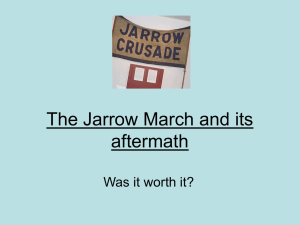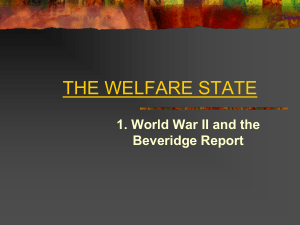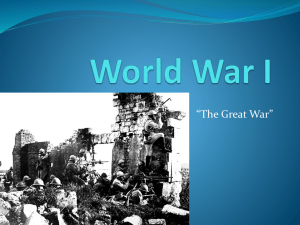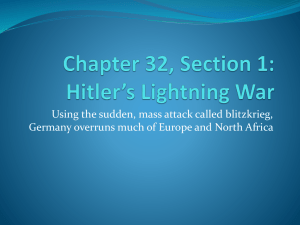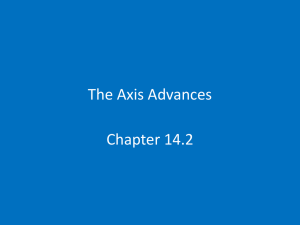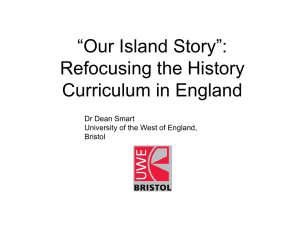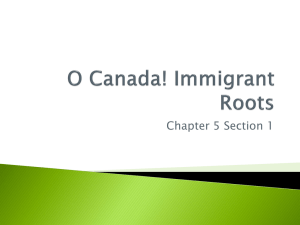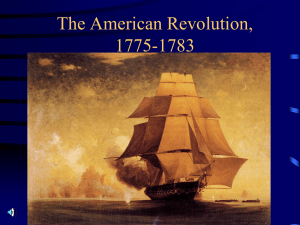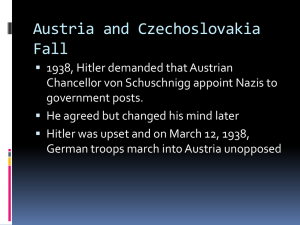History_Revision-_Unit_Three_-_Britain
advertisement
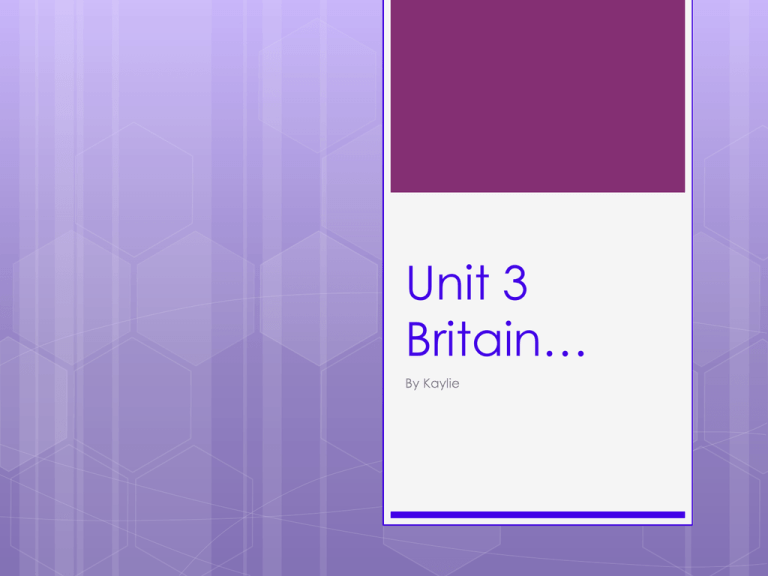
Unit 3 Britain… Key Topic 1 Impact of the Depression Background for unemployment At the end of World War One national insurance was the only thing available to those out of work and this was only paid for 15 weeks and available to some unstable industries. In 1918 the out of work donation scheme (dole) was set up but was mainly aimed at returning soldiers and was quite small. In the 1930s after the depression unemployment was at 2.4 million people. This lead to many protests and marches to London called Hunger Marches. They we organised by the National Unemployed Workers Movement. They wanted more work not benefits. Unemployment and Labour in the 1930s The main industries hit were iron, cotton, coal and shipbuilding. In 1932 62% of all shipbuilders were unemployed and 34.5% of miners. However not everyone suffered. In London many new factories were built and this kept up employment in London and the south east. Labour came into power in 1929 with Ramsay MacDonald. As a government they had to borrow money and make huge cuts. 15% was suggested to be cut from benefit rates and a gruesome means test was to be set up. However this was refused by most ministers and the government fell The National Government MacDonald set up a National Government which was a mix of many moderate MPs and won an election in October 1931 who managed to cut the benefit rate by 10% but although this happen the government still had to pay out more as more people were claiming. They also introduced things like the special areas act but this didn’t have much effect as it was too little and poorly distributed. Life as an Unemployed and Jarrow To be eligible for benefits each week you had to sign on at the employment exchange to show that you were looking for work. Everyone not on NI had to go though a means test to get their dole money. Jarrow was a town that had been “helped” by the special areas act but the money given was just too little. When their local shipyard shut in 1934 64% ended up unemployed. Jarrow March The people of Jarrow decided to hold their own march and sent 200 of their fittest men to London with a petition. It was different from the Hunger marches and was named the Jarrow Crusade and the banners were black and white, not red. On their way to London they made many stops to hold public meetings for their cause. Reaction to the marchers varied and sometimes they ended up sleeping in the work house but others they were let in free to cinemas and public baths. Results of Jarrow On the 31st of October they reached London but during the marches the government cut off their benefits because they were not able for work. The petition was accepted finally but wasn’t debated in parliament. Some marchers were offered jobs but these involved leaving Jarrow which all marchers were reluctant to do. The march was said to have failed as they didn’t achieve their aims although they did inspire other marches. Key Topic 2 Britain Alone WAR! And Winston Churchill… When Britain went to war in September 1939 the BEF (British Expeditionary Force) were sent to Frances borders. But the Germans attacked though the Netherlands, Luxemburg and Belgium, which surprised the allies. Winston Churchill was an MP who was constantly criticising the government for the policy of appeasement and was put in charge of the navy. On the 10th May 1940 he was made prime minister. Blitzkrieg… (not good news for Britain) In 1940 Germany invaded Denmark and Norway without declaring war and used blitzkrieg tactics to take over. Planes Bomb area. Tanks take over area Troops move in and artillery fire. Troops occupy and put down resistance as planes and tanks go to next area. It was very important to make sure the previous area was safe when moving to the next. The tactic threw the British into confusion and the allied forces were evacuated through Dunkirk. Operation Dynamo May 21st 1940 was when allied troop reached the only port not held by the Germans. 300 boats of small fishermen and went to Dunkirk by 29th and they managed to bring home 338,000 troops home after estimating a maximum of 30,000. Operation Dynamo was a huge morale boost for the British and although it was only an evacuation, it stole many troops from the overconfident Germans, which was a good thing. Operation Sealion (e.g. Britain are SREEWED…) France surrendered on 22 June 1940 and this left Hitler with only one target, Britain (apart from USSR etc.). Operation sealion was the German invasion of Britain. Time for another diagram I think… 10 July- 7 August Luftwaffe attacks the coast and radar systems. (Meanies) 8 August6 Septemb er Luftwaffe attack RAF air fields. (slightly irritating thanks) 7-15 Septemb er The stupid Luftwaffe think RAF are beaten so attack London… (not really HA HA) 15 September LUFTWAFFE LOSE Mini raves commence 17 Septemb er Hitler gives up on operatio n Sealion (because the British are just too cool) Why Are the British so epic? The British only had 640 fighter planes compared with the Germans 2600. However the British spitfires were much better designed than the German ones. Also the British had radar systems which helped detect when the Germans were coming close. The British also replaced and fixed planes a lot quicker than the Germans did and they had the Dunkirk spirit. War Prep. The Air Raid Precautions service was set up with voluntary ARP wardens. Councils were told to build air raid shelters as early as 1935. Sand bags were put out and blackouts were organised which were checked by ARP wardens. The wardens also checked people went to air raid shelters. From 1939 Anderson shelters were given out. In 1940 the Local Defence Force were set up. They were later renamed the Home Guard and they were very over subscribed. They manned anti aircraft guns and helped rescue workers and put obstacles on large fields to prevent German landing. They were really good. Evacuation and The Blitz Most people who were evacuated were children and they were mainly taken to the countryside. The evacuation started on 1 September 1939 but as there had been no bombs by December most went home for Christmas. The Blitz was the systematic bombing of Britain and started in 1940s. It affected cities like Liverpool and London. London was bombed 75 out of the first 76 nights. It really disrupted life for civilians. Coventry and The Blitz On the 8th November 1940 Britain bombed Munich and in retaliation they bombed Coventry. Very heavily. 500 bomber planes dropped thousands of bombs and the burning city was visible from 150 miles away. The Luftwaffe returned to the city 40 times but the first time was still the worst. V1s, V2s and the Baedekers Raids (cities of no military importance) The Germans were said to have picked the places with three star ratings in a tourist guide to Britain. They were slightly mad, just like Hitler. The German developed new and improved bombs called V1s and V2s. The V1 was noisy and cut out before it exploded but the V2 was silent. They were both sent over from the coast of France and cause about 1.5 million people to leave London. Key Topic 3 Britain at War The Overprotective Government The government needed tight control over Britain when it was at war and introduced things like rationing and blackouts and the information to go with it. Pacifist who spoke against the war publicly were often arrested. The government also set up different ministries to control and organise things which were important in a war like the ministry of supply which took over the iron and steel industry. The ministry of information was also set up. Ministry of Information (they actually censor information…) The most important part of this ministry was censorship and propaganda. Its aims were to prevent anything circling that would demoralise the British people. Letters from soldiers were censored. Propaganda was also one of this ministry's job and they made many posters and short videos telling people thing like not to talk carelessly about the war and what to do in a blackout. They also encouraged patriotic feeling in the people. Rationing Before the war 70% of food was imported and this wasn’t possible during war time as German U boats were sinking the import ships. Rationing started 8th January 1940 and people got small rationing booklets. People were also encouraged to grow there own food and keep animals like chickens or rabbits. A highly priced black market flourished as there was little variety in what food people ate. Women Working On the 8th December 1941 conscription was introduced for all unmarried women ad later for older single women and then married women. By 1943 there were over 100,000 women working on railways. The ATF (army), WAAF (air force) and Wrens (navy) were all different sevices where women worked for the war effort. They were not allowed in combat but could be used as spies although were mainly used for office work in the beginning. Women After the War and DDay… After the war many women were dismissed from the jobs they had been “minding” for men and went back to how they used to be. It was still more important for men to find job even though attitudes had been changed. OPERATION OVERLORD was D-Days code name. The bombing of pearl harbour by Japan had caused America to join the war and they helped with operation overlord on the night of 6th June 1944. The allies leaked information that the landing would be in a different location to where they actually were. D-Day and its Success The allies managed to attack many of the radar stations and managed to suggest that the bombing would be near Calais. They also managed to sustain the Pluto fuel pipe line and ferry over troops and supplies very quickly Para troopers were also important as they helped to blow up train lines and disrupt German communication. Being backed up by the USA was also useful as it meant that loses of men were not to have such a great impact on operation overlord. Germany DEFEATED. After D-Day Germany was being pushed from both sides and was running out of soldiers and equipment. The allies stepped up their bombing of towns and cities and bombed enemy submarines. However the allies did suffer loses at Arnhem in September 1944 while trying to free the Netherlands and only 2827 out of 10,300 survived. The German planned assassination of Hitler failed as he got rid of everyone who might be a conspirator. After Arnhem the surprise Battle of the Bulge was launched by the Germans but the Germans lost irreplaceable men while the allies just brought in more troops. In April 1945 Hitler committed suicide and Germany was able to surrender. Key Topic 4 Labour in Power Here Come Labour At the end of the war rationing was worse as famers needed time to grow their crops again and factories time to start making clothes instead of war supplies. People wanted a socialist state after the war and Labour were the people to do that. After VE day Churchill and Attlee wanted to keep the coalition until Japan was defeated but the Labour and Liberal parties wanted an election, a fresh start. Churchill thought that is could benefit him to have an election at then end of there war because he could use his war popularity to win. This was heavily relied on by the conservatives in the election which was one of the many mistakes made. The Campaign Churchill was the main focus of the Conservative campaign and slogans like “let him finish the job” we used in propaganda posters. But what he didn't realise is that the people wanted peace, which is what the labour campaign focused on, not a war leader. A mistake made during one of the first election broadcasts Churchill said that Labour would need to have a Gestapo. This annoyed many of the soldiers that had fought the Nazis and wasn’t easily forgotten. This slip of the tongue was then a feature of many jokes about Churchill because Attlee was such a small, non violent looking person. The Beveridge report This report was written by William Beveridge who was on a committee to suggest how to improve British life. The report was over 300 pages long but sold over 70,000 copies in the first few days. The report itself suggested that there were five “giants” that we had to fight: want, ignorance, disease, squalor and idleness (as in unemployment not just being a couch potato). The government control levels during the war made people see what other parts of life they could be responsible for and changed many peoples view on what the state should provide. Most people in Britain supported the report and it was frequently debated in parliament. Changes due to The Beveridge Report The national government passed the family allowance act in 1945 but payments didn’t start till a year after so Labour got credit for them. The Labour government were elected because many people didn’t think that a conservative government would act on the Beveridge report. The labour government built 17 new towns in England under the new towns act 1946. Under the Education act 1947 education was free up till 15. From 1945 the government schemes start to provide work. The National insurance act meant that the government provide sick, maternity and unemployment benfits. 1946 NHS act means free health care. The NHS The British Medical Association (BMA) completely disagreed with having a national health service as they were worried that the state would control them. The health minister pushed the law through parliament while consulting the BMA because it was known they were not very open to it. The NHS was very popular and the government had majorly underestimated what the costs would be and the NHS was being used a lot. Glasses and false teeth were the most popular so by 1951 people had to contribute 1 shilling towards them but the poor, old and disabled didn’t have to pay. The poor were not the only people making the most of the NHS, many middle class people used it happily as well
